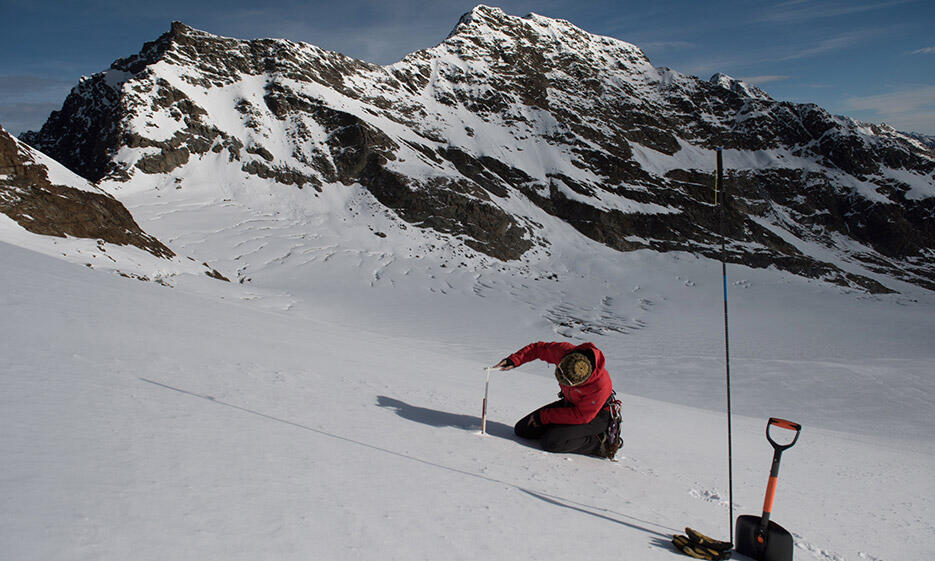The glaciers in the upper Rofental are well monitored offering good opportunities for integrated catchment studies. Most glaciological data will be recorded and updated in the living data repository associated with Earth System Science Data publication on The Rofental: a high Alpine research basin (1890–3770 m a.s.l.) in the Ötztal Alps (Austria) with over 150 years of hydrometeorological and glaciological observations
Glacier inventories:
All the glaciers of the upper Rofental are included in the Austrian glacier inventories, and are available as shapefiles online
| Inventory of Austrian glaciers during the Little Ice Age (LIA) |
data |
| 1st Austrian glacier inventory (1969) |
data or data |
| 2nd Austrian glacier inventory (1997-1998) |
data or data |
| 3rd Austrian glacier inventory (2006-2012) |
data |
| 4th Austrian glacier inventory (2015) | data |
Key publications about the Austrian glacier inventories:
- Fischer, A et al. (2015): Tracing glacier changes in Austria from the Little Ice Age to the present using a lidar-based high-resolution glacier inventory in Austria. The Cryosphere, 9(2), 753-766, https://doi.org/10.5194/tc-9-753-2015
- Buckel, Johannes; Otto, Jan-Christoph; Prasicek, Günther; Keuschnig, Markus (2018): Glacial lakes in Austria - Distribution and formation since the Little Ice Age. Global and Planetary Change, 164, 39-51, https://doi.org/10.1016/j.gloplacha.2018.03.003
Direct glaciological mass balance measurements:
A number of glaciers have their mass gains and losses monitored by direct field measurements. Some of these are among the longest time series of such records in the Alps. The glacier mass balance data is available via the World Glacier Monitoring Service, and are also recorded in the repository associated with Earth System Science Data publication on The Rofental: a high Alpine research basin (1890–3770 m a.s.l.) in the Ötztal Alps (Austria) with over 150 years of hydrometeorological and glaciological observations
| Hintereisferner |
1953 - present |
data |
website |
| Kesselwandferner |
1953 - present |
data |
website |
| Vernagtferner |
1965 - present |
data |
website |
| Hochjochferner |
1991 - 1995; 2014-2015 |
data |
The glacier mass balance monitoring of Hintereisferner is carried out by ACINN, subject to a contract with the Hydrographic Service, Government of Tyrol and additionally funded by the University of Innsbruck. There exist a Mass balance of Hintereisferner webpage, where you can find and download several annual mass balance reports.
The Department of Geodesy and Glaciology, Bavarian Academy of Sciences and Humanities, Munich, Germany carries out a comprehensive program of glaciological monitoring on Vernagtferner. Details and data are available at their webpage.
Geodetic glacier mass balance:
Geodetic mass balance calculated by measuring the volume change of the glacier has been carried out on the basis of the glacier inventories and regional digital terrain models for a number of years.
Key publications about glacier geodetic mass balance:
- Klug, C., Bollmann, E., Galos, S. P., Nicholson, L., Prinz, R., Rieg, L., Sailer, R., Stötter, J., and Kaser, G. (2018) Geodetic reanalysis of annual glaciological mass balances (2001–2011) of Hintereisferner, Austria, The Cryosphere, 12, 833-849, https://doi.org/10.5194/tc-12-833-2018, 2018.
-
Fischer, A., H. Schneider, G. Merkel, R. Sailer (2011) Comparison of direct and geodetic mass balances on annual time scale, The Cryosphere Discuss., 5, 565-604. https://doi.org/10.5194/tc-5-107-2011
Remotely sensed data from which geodetic mass balances are derived is listed on remotely sensed data site.
Ice thickness measurements
Glacier thickness is an important factor in the course of glacier retreat in a warming climate. A study data presents the results (point data) of GPR surveys on 66 Austrian mountain glaciers carried out between 1995 and 2014. data
Webcam views onto glaciers
Glacier velocities
In 1895 surface velocities of Hintereisferner were measured by surveying stone lines and maps were drawn.
Glacier velocities have been monitored irregularly by accurately surveying stone lines on the glacier surface. This work is currently done by the Verein Gletscher und Klima.
A paper on 100 years of ice dynamics of Hintereisferner, Central Alps, Austria, 1894-1994 were published 1997 by Span et al..
Glacier surface roughness measurements on Hintereisferner
In summer 2018, a series of geometrical and aerodynamical surface roughness measurements were made at the glacier as part of the INTERACT GLARE project (GLacier Aerodynamic Roughness Estimation) led by Dr Mark Smith of the University of Leeds.
